Nematode Biology and Management in Corn
Crop Insights written by Mark Jeschke, Ph.D., Agronomy Manager, and Ron Sabatka, Seed Applied Technologies Marketing Manager
Crop Insights written by Mark Jeschke, Ph.D., Agronomy Manager, and Ron Sabatka, Seed Applied Technologies Marketing Manager
Nematodes are a well-known pest of soybeans, but are frequently overlooked as a cause of yield loss in corn. Nematodes that affect corn are difficult to detect due to their small size, and the symptoms they cause often resemble symptoms of common stress factors such as drought or nutrient deficiencies. Today, however, there is a growing realization that nematodes can and do economically affect corn.
Over 50 species of nematodes are known to feed on corn in the U.S., several of which can cause significant economic damage. Corn nematodes are commonly thought of as a pest specific to sandy soils, such as in Kansas and Nebraska and the coastal plains of North and South Carolina. While this is true of some species, other species can exist in a range of soil conditions. No field is immune to the potential for nematode damage.
Nematodes normally do not kill plants but act as parasites on the host plant. If plant death did occur, nematodes would be more obvious and of more concern to growers. Instead, these microscopic roundworms often increase without being detected. This trait has earned them the reputation of “silent yield robbers” of corn.
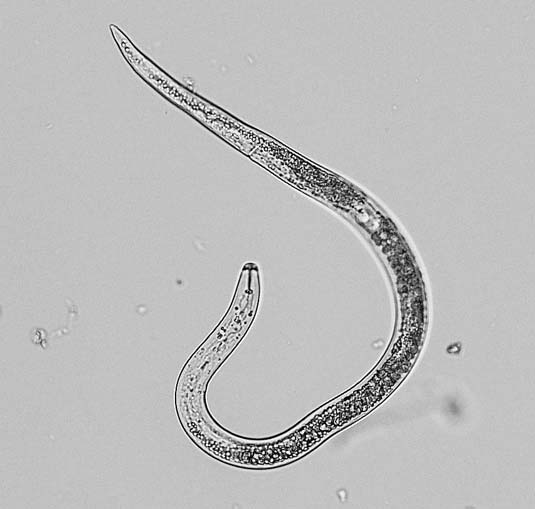
A lesion nematode, one of the more ubiquitous nematode pests of corn.
The capability of nematodes to damage corn has been known since the 1950s, however recent trends in farming practices may be increasing nematode numbers as well as their economic importance as corn pests. Reduced tillage is known to favor some nematode species, as is corn following corn. It is also likely that reduced use of carbamate and organophosphate insecticides for rootworm control in corn has caused an increase in nematode populations. These rootworm insecticides also have activity against nematodes, whereas newer alternatives such as pyrethroid insecticides and transgenic rootworm-protected corn do not.
Additionally, our ability to sample and diagnose nematode damage has improved. Symptoms that may have previously been attributed to some other stress factor are now correctly being traced to nematodes.
Nematodes are the most abundant multicellular organisms on earth, and are ubiquitous across a wide range of ecosystems. Nearly 20,000 species have been described, although the biology of most species is poorly understood. Most species are microscopic, typically ranging from 0.25 to 3.0 mm in length, although some species are much larger.
The life cycle of corn nematodes is similar to other nematodes – juveniles hatch from eggs and pass through multiple larval stages to the adult stage. During each larval stage, a molt happens where the cuticle is shed and the nematode increases in size. Both juvenile and adult nematodes feed on the roots of the host plant. The length of time required to complete a life cycle varies widely among species, from several days up to a year. The most common corn nematodes complete their lifecycle from egg to adult within about 30 days. Nematodes typically travel no more than 1-2 meters during their lifecycle.
Nematodes are notable in that juveniles hatch in a “unisex” form and their sex is determined later in life. Those that become males move through the soil and probably don’t contribute to plant damage, according to the scientific literature. In some species, males are rare and not required for reproduction or are absent entirely. Those that become female nematodes feed and reproduce additional nematodes as the life cycle begins anew. The eggs that females produce are the overwintering structure for these organisms.
Plant parasitic nematodes are typically soil-borne and feed on plant roots. Nematodes use a stylet to pierce the corn root and extract nutrients. However, nutrient loss is only one of the negative effects of nematode feeding. Tissue damage at the feeding site can provide easy entry into the root system for commonly associated root pathogens. Nematode populations increase as their food source, corn roots, develop. Corn nematodes prefer feeding on new succulent cell tissue where cells are dividing, however all root area is susceptible to damage. Nematode damage can occur throughout the growing season; however, corn is most vulnerable during early-season crop establishment.
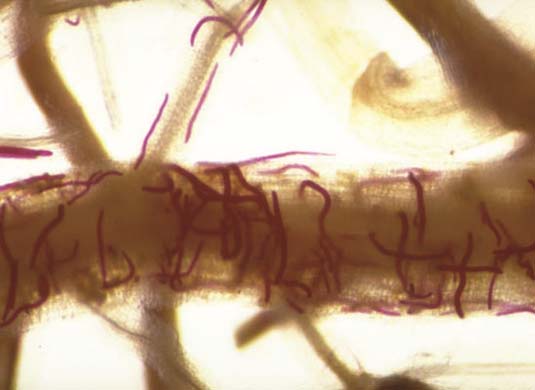
Lance nematodes feeding on a root. Photo courtesy of Greg Tylka, Iowa State University.
Nematodes species vary in their feeding behavior, but all feeding types can have a significant effect on corn yield.
Ectoparasites – Nematodes live in the soil and feed on the surface of root tissue by inserting the stylet into cells within reach. Examples include sting, needle, dagger, and stubby-root nematodes.
Endoparasites – Nematodes that fully penetrate root tissue and feed within. Endoparasitic nematodes can be subdivided into migratory and sedentary endoparasites. Migratory endoparasites remain mobile, feeding as they move through the plant tissue. They spend most of their lifecycle in the plant tissue, but can also be found in the soil. Sedentary endoparasites enter the plant tissue and develop a permanent feeding site. Examples of endoparasitic nematodes include root-knot, lance, and lesion nematodes.
Semi-endoparasites – Nematodes partially enter plant tissue, leaving the rear part of their bodies projecting into the soil. Examples include reniform nematodes.
Nematodes frequently remain undetected as a cause of plant injury. Their small size makes them virtually invisible and the damage they cause is often overlooked or mistaken for some other plant stress factor. However, if nematode numbers have increased to the point that they are causing economic damage, visual symptoms are usually apparent in “hot spots” in the field. These visual symptoms are similar to those often associated with soil compaction. Plants may appear to be moisture-stressed, stunted and chlorotic, or exhibit less extreme signs of generally poor plant growth. These symptoms are often mistaken for another problem, such as low fertility, weather stress, or insect or disease pressure.
Most often these symptoms don’t appear over a very wide portion of the field. No specific patterns are usually identifiable with nematode damage, although as the problem grows, it often moves in the direction of field tillage. This is due to the physical movement of the nematodes with soil in tillage operations.
Root symptoms may vary, as may above-ground symptoms. Root pruning is usually evident, as well as proliferation of fibrous roots, thickening or swelling of the smaller roots, and mild to severe discoloration. Soil may stick to the roots due to the oozing of damaged cell contents.
Nematodes are similar to weeds and insect pests of corn in that there are many species of nematodes with different biological characteristics that are capable of reducing corn yield. Different soil environments will favor different nematode species.
It is difficult to establish widely applicable economic thresholds for nematode populations given their tendency for patchy distribution and other stress factors that can influence yield reduction. Economic thresholds established by universities can vary greatly from state to state. Scientists at Corteva Agriscience have developed high population indicators for major corn nematode species as a relative measure of low, medium or high population levels. The foundation of these indicators is university and nematologist thresholds plus yield results from Corteva research trials. The purpose of the high population indicator is to simplify characterization of nematode population levels while taking into account varying thresholds across states.
Corteva Agriscience research has focused on seven economically important nematode species in corn. These seven species are considered economically important based on a combination of prevalence and crop injury potential.
Sting nematodes are found in the sandy plains of the Atlantic and Gulf coast states, as well as sandy areas in Midwestern states including Kansas and Nebraska. They are ectoparasites that feed on the outside of roots without attaching to or penetrating the root tissue. Sting nematode eggs hatch in approximately 5 days, and reach full adult stage in 18-28 days. They migrate downward through the soil profile as roots develop, soil temperature rises, and moisture declines.
Feeding occurs at the tips and along the sides of the roots and can result in girdling and death of the root. Sting nematodes inject a highly toxic substance into the root tissue before feeding. Injured areas will appear blackened and sunken. Sting nematodes are very large (approx. 3 mm) and are restricted to soils with at least 70% sand. They can be very damaging, however, particularly when stubby-root nematodes are also present. Severe corn yield losses above 50% have been reported. Sting nematodes have a wide host range, including soybean and cotton; thus crop rotation alone will not provide effective management.
Needle nematodes are the most devastating type of corn nematode in the Midwest, but are usually confined to sand and loamy sand soils due to their large size. Needle nematodes are relatively large at 3 to 8 mm long, and the greater pore space in sandy soil is necessary to accommodate their size. Yield reduction can be severe, exceeding 60% in the most extreme cases. Corn roots will appear stubby due to pruning of the finer roots, and the above-ground portion of the plant will appear stunted, with symptoms resembling drought stress. Needle nematodes migrate downward as roots develop, soil temperature rises, and moisture declines. Needle nematodes feed primarily on grass species, so rotation to soybeans or another non-grass crop can be an effective management tool.
Lance nematodes are also very potentially damaging. Like needle nematodes they are relatively large (approx. 1.5 mm), making sandy soil their most suitable habitat. They are not limited to sandy soil however, and can be found in a wide range of soil types. Lance nematodes have a wide host range, which can limit the effectiveness of crop rotation as a means of control. At least four Hoplolaimus species are known to affect corn. H. galeatus is prevalent throughout the U.S. and is the most common lance nematode in Midwestern corn fields.
H. columbus, commonly known as Columbia lance nematode, is common in southern states where it can also be a damaging pest in soybean and cotton.
H. galeatus can exist in a range of soil types, whereas H. columbus is much more limited to sandy soil. Lance nematodes are initially ectoparasitic, but can partially or completely penetrate the root tissue. Lance nematodes cause stunting in corn early in the season which results in spindly plants with reduced yield at harvest.
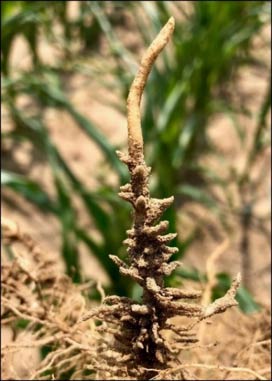
Corn root system showing severe feeding damage from lance nematodes. Root exudate from severe feeding will cause soil to stick to the roots, as seen here. Photo courtesy of Jim Lafrenz.
Stubby-root nematodes are common in corn in the U.S. across a wide range of soil types. Stubby-root nematodes are ectoparasites that feed on the root tips resulting in short, stubby roots which can resemble herbicide damage. Affected plants will be stunted and yellow and may show magnesium deficiency. Corn is the preferred host of stubby-root nematodes; however, they have a wide host range including many other crop species such as cotton, soybean, and sunflower.
Root-knot nematodes are sedentary endoparasites that spend the majority of their lifecycle inside the root tissue. There they form small galls on the roots. Multiple species of root-knot nematodes affect varying ranges of host crops throughout North America, so effective management requires knowledge of the specific species present. Of the four most common species, corn is a host for three. Root-knot nematodes generally have a wide host range, which limits the effectiveness of crop rotation as a means of control. Alfalfa and oats are non-host crops that may be rotated with corn to reduce populations; however soybeans are a host crop and can be damaged even more than corn, particularly in the southern U.S. The southern root-knot nematode (M. incognita) is a serious pest of cotton, and rotation with corn can increase the chances of cotton yield loss. Research has shown resistance in certain corn inbreds and hybrids, however most current hybrids are not resistant to root-knot nematodes.
Dagger nematodes are another relatively large type of nematode, making them favored by, but not limited to, sandy soil. Dagger nematodes have a wide host range and are important pests in many other crops, most notably grapes and other fruits. One species, X. americanum, is known to have a very long lifecycle. This species reproduces once per year and can live 4 to 5 years in undisturbed soil with favorable conditions. Crop rotation is not an effective means of control for dagger nematodes; however, tillage may disrupt their lifecycle and help reduce population numbers. Feeding on corn roots by dagger nematodes can cause stunting and chlorosis. In addition to causing root damage, Dagger nematodes can transfer viral mosaic and wilting diseases.
Although not the most damaging type of nematode, lesion nematodes are considered to be the most important genus to Midwestern corn production due to their prevalence. Lesion nematodes are widespread, and population densities of 10,000 nematodes/cm3 of soil are not uncommon. This genus is found in a wide range of soil types. There are six species in this genus that are known to feed on corn. Lesion nematodes are migratory endoparasites that alternately feed and move within the root tissue. Symptoms include severe root pruning resulting in stunting, chlorosis, and discoloration. Crop rotation has been shown to be effective at reducing lesion nematode numbers.
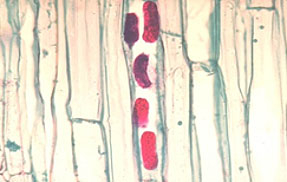
Lesion nematode eggs in corn root tissue. Photo courtesy of Greg Tylka.
Spiral and stunt nematodes are very widespread in the Midwestern U.S. Three species of spiral nematode are known parasites of corn. Unlike many nematodes, they favor heavier soils rather than sand. Spiral nematodes are named for their characteristic spiral body shape when inactive. Stunt nematodes also tend to favor heavier soils Both species are ectoparasitic and can cause damage to corn when populations are large or in conjunction with other nematode species, however yield loss in corn is rare. Other host species include soybean, clover, and turfgrass.
Ring, sheath, and pin nematodes are all sedentary ectoparasites that tend to feed at a single site on the surface of the root tissue. Ring and sheath nematodes are rare in cultivated crops and more commonly parasitize perennial plants in undisturbed soil. Ring nematodes tend to favor sandy soil, whereas pin nematodes are very small and prefer finer-textured soil.
The biology of the corn cyst nematode is similar to that of the soybean cyst nematode. Its first discovery in North America was in Maryland in 1981. Fields known to be infested in Maryland and Virginia were quarantined from 1981 until 1996. It is known to have a higher optimal temperature than the soybean cyst nematode, which may limit the suitability of fields in the Corn Belt as a host environment. A new corn cyst nematode species, now known as the goose-grass cyst nematode, was found in Tennessee in 2006. Research conducted so far has confirmed that this species is different from H. zeae, and shown that corn is a favorable host, whereas dicot species such as soybean are not. Whether this species will spread as an economically significant pest of corn is unknown.
The soybean cyst nematode undoubtedly is the most widely known nematode species in the Corn Belt. Although many nematode species can damage soybean, soybean cyst nematode is by far the most important. Soybean cyst nematode does not pose a threat to corn.
The reniform nematode is a serious pest of cotton in the southern U.S. Soybean is also susceptible to reniform nematodes, however corn is not.
In 2018, Corteva Agriscience researchers conducted a survey of corn nematode populations across 10 Corn Belt states (Figure 1). Nematode populations were sampled at 67 locations planted to corn in 2018. At each location, samples were collected from 3-5 different evaluation zones within the field to evaluate uniformity of nematode pressure across the field. A total of 238 evaluation zones samples were collected across the 67 locations. Samples were taken when corn was between the V3 and V6 growth stage.
Each location included a field-length nematicide seed treatment strip trial to measure yield loss associated with nematode damage. Trials included a strip planted to a Pioneer® brand corn product treated with a fungicide and insecticide seed treatment plus Lumialza™ nematicide seed treatment and an adjacent strip without the nematicide seed treatment.
All locations and zones had corn nematode populations present at some level. Dagger and lesion nematodes were the most common species in the survey, both appearing at over 50% of locations (Figure 2). Sting nematodes were not found at any of the locations, as no locations sampled had soils sufficiently sandy (>70%) to support sting nematode populations.
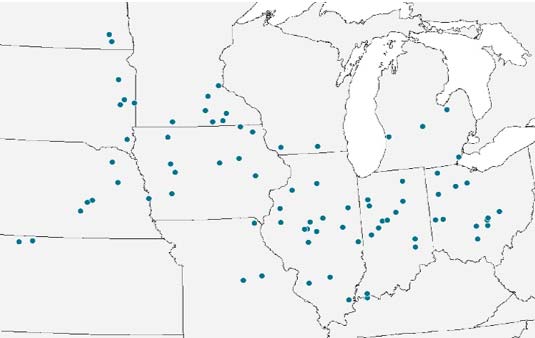
Figure 1. Corn nematode sampling locations in the 2018 Corteva Agriscience survey.
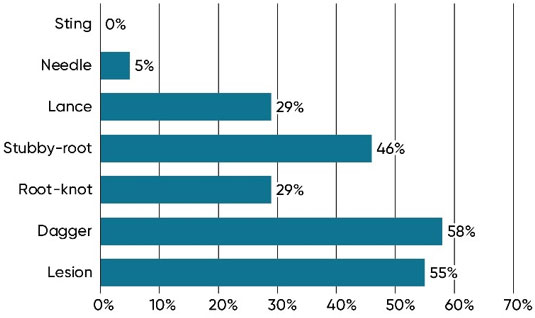
Figure 2. Frequency of detection of seven corn nematode species at 67 survey locations in 2018.
Nearly half of the sample locations had one or more zones with moderate to high populations of at least one nematode species (Figure 3). High population in this survey was defined as exceeding the high population indicator level and moderate pressure was defined as greater than 50% of the high population indicator level. Of the 238 evaluation zones, 35% had moderate to high nematode populations, showing that nematode pressure is often uneven across a field.

Figure 3. Proportion of locations sampled in 2018 with low nematode populations and moderate to high populations.
Yield loss associated with nematode damage was measured by comparing corn yield with and without nematicide seed treatment within evaluation zones. In zones with moderate to high populations of at least one nematode species, yield in the non-treated strip was reduced by an average of 6.7 bu/acre, compared to a reduction of 3.7 bu/acre in low population zones (Figure 4).
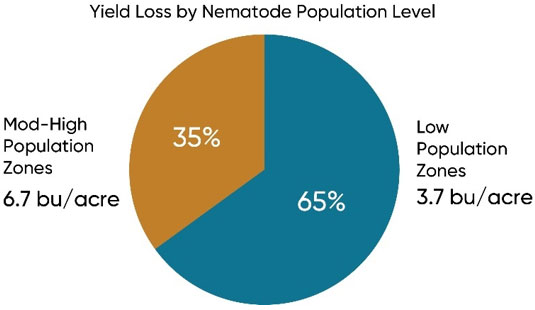
Figure 4. Corn yield loss in evaluation zones with moderate to high nematode population levels and low population levels.
Nematodes should be sampled when populations are likely to be the highest. Healthy plant tissue is vital to nematode survival, so samples should be taken in fields where corn crop is actively growing and the nematodes have hatched and begun feeding.
Optimal timing for nematode sampling can vary based on soil characteristics. In sandy soils, samples should be taken early in the growing season when the corn is around the V3-V6 growth stage. The most damaging nematodes in sandy soils, sting and needle nematodes, are both known to migrate deeper in the soil profile during the growing season. Samples taken later in the season may underestimate population levels if the nematodes have moved below sampling depth. Fields with finer-textured soils can be sampled throughout the growing season or after harvest.
Samples can be taken during early vegetative growth when areas of suspected nematode damage are visible. When sampling an area of potential nematode injury, samples should be taken from:
A great deal of soil is not needed for a nematode sample. Specific recommendations from your local lab should be followed, but keep these ideas in mind:
Nematodes are one problem that will not go away if ignored. If damaging levels of corn nematodes are found, implementing control measures such as rotation, sanitation or use of nematicides should be considered.
Rotation to non-host crops can be an economical method of controlling species plant parasitic nematodes that have a limited host range. Most of the major species of corn nematodes however, have a wide host range and are unlikely to be affected by crop rotation. Exceptions include needle nematodes which are limited to grass species, making rotation to soybeans a useful management tool. More diverse rotations including alfalfa or oats can help reduce populations of root-knot nematodes.
For rotation to be an effective management tool, eliminating alternate hosts during the non-corn growing seasons is important. Weeds may serve as alternate hosts for some nematode species, so effective weed management is important in rotated crops. Farmers are encouraged to check with local university extension sources for a list of local alternate host crops and weeds.
Pioneer® brand corn products are available with two seed treatment options for nematode control.
Lumialza™ nematicide seed treatment is a new biological product that contains the active ingredient Bacillus amyloliquefaciens – Strain PTA-4838 and has activity against all seven primary corn nematode species. Lumialza™ nematicide seed treatment colonizes the roots forming a bio-barrier that protects roots from nematode attack. It also produces materials which cause juvenile nematode paralysis.
Two key benefits of Lumialza™ nematicide seed treatment are the area and duration of protection it provides. The zone of protection encompasses the entire area of root growth including between the rows and deeper in the soil profile, in contrast to hard chemistries which create a zone of protection around the placement of material which may be 3-6 inches around the seed. Research has shown that nematode protection lasts for more than 80 days in the upper, middle, and lower root zones.
Poncho® 1250 + VOTiVO® insecticide provides broad spectrum control of corn soil insects, plus the added protection of Poncho/VOTiVO insecticide for corn nematodes. Poncho/VOTiVO insecticide contains a unique strain of bacteria that lives and grows with young corn roots, creating a living barrier that helps protect corn seedlings and roots against nematodes.
Because nematodes cannot be eradicated once they are established in a field, prevention is a critical management strategy. Common-sense sanitation procedures can prevent movement of nematodes from known areas to uninfested fields or field areas. Equipment should be cleaned with high pressure water or steam to remove soil particles before moving to an uninfested area. Field operations should be conducted last in infested areas if possible.
July 2019

State registrations for Lumialza™ nematicide seed treatment are pending. This product may not be registered for sale or use in all states. Contact your local Corteva retailer or representative for details and availability in your state.
Lumialza™ nematicide has not yet received regulatory approvals in any country outside the United States; approvals are pending.
The information presented here is not an offer for sale. This presentation is not intended as a substitute for the product label for the product(s) referenced herein. The information contained in this technical presentation is based on the latest to-date technical information available to DuPont, and DuPont reserves the right to update the information at any time.
The foregoing is provided for informational use only. Contact your Pioneer sales professional for information and suggestions specific to your operation. Product performance is variable and subject to any number of environmental, disease, and pest pressures. Individual results may vary.
Poncho® and VOTiVO® are registered trademarks of BASF.